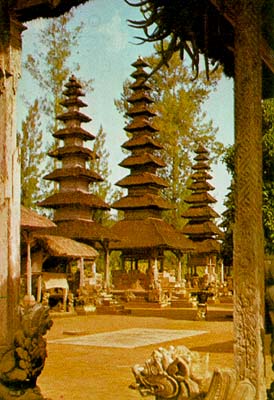
Mengwi / Taman Ayun
|
|
A turnoff
toward the mountain leads to the principality of Mengwi which, until
1891, was the center of a powerful kingdom originating from the Gelgel
dynasty. These kings continue to be venerated in the state temples of
Mengwi, in particular Pura Taman Ayun.
|

|
|
In Bali,
each social unit of increasing size beginning with the family possesses
a temple wherein they worship deified ancestors. The family ancestors
are worshipped in the house temple, the clan ancestors in the clan
temple, the founders of a village in the Pura Puseh, and previously the
ancestors of a royal dynasty were collectively worshipped by a kingdom
in the state temples. State temples include mountain temples, sea
temples, and those at the heart of the kingdom, such as Mengwi's Pura
Taman Ayun.
|
|
Among the
rows of palinggihs, (shrines that serve as "sitting places" to receive
visiting deities during temple feasts) is a brick building facing east:
the paibon, a royal ancestral altar. In the surrounding pavilions,
priests recite prayers, village elders hold council, offerings are
prepared, furniture and the temple's musical instruments are stored.
For those interested in traditional woodcarving, the small doors of the
shrines here are beautifully carved. The moat gives the impression of a
sanctuary in the middle of a pond, explaining the name taman, "garden
with a pond". The waters are a symbolic place of contact with the
divine through widadaris, celestrial nymphs who bathe there.
|
|
Beyond the
moat, the temple lies on slightly rising ground. The grassy expanse of
the outermost courtyard, the fine array of merus and pavilions in the
inner courtyard, and its well-kept appearance make it one of the most
beautiful temples in Bali. Originally dating from 1634, Taman Ayun was
restored and enlarged in 1937. On its festival day (odalan) hundreds of
women file into the temple bearing colorful offerings, which they place
together before the merus.
|
Copyright
2001-2015, K&D Bali Designs. All rights reserved.
|